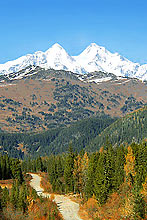Nature of the Southern Altai
 Situated in the north eastern part of Kazakhstan and bordering on Russia, China and Mongolia, at the 76 - 87° EL and 48 – 51° NL (at a latitude of Paris) the oblast is noted for extreme diversity. Situated in the north eastern part of Kazakhstan and bordering on Russia, China and Mongolia, at the 76 - 87° EL and 48 – 51° NL (at a latitude of Paris) the oblast is noted for extreme diversity.
In Southern Altai every type of landscape is found, including desert, steppe, taiga, mountains with glaring glaciers, numerous rivers and lakes. The same is with climate -severe frosts in winter are alternated with heat in summer.
In the northeast is the sparkling Belukha Mountain (4,506m), the highest in Siberia and Altai. It is a kingdom of snow, ice, roaring avalanches, sparkling waterfalls – a majestic mountainous realm.
The first explorers were awestruck by the beauty of the area, which they could compare only to that of Switzerland. In the first maps of Altai one finds such names as Severo-Chuysky Alps and Katun Alps. It was not in vain that they were named Altai - Golden Mountains from Mongolian.
Many rivers rise on the 890 sq km Katun range to further divide into two basins-the Katun River (Altai republic) and the Irtysh River (Eastern Kazakhstan) and to run across alpine meadows, cedar taiga and whimsical rocks. The crystal-clear rivers abound in grayling and taimen.
One who has ever seen Lake Markakol - the most beautiful in the region, will never forget the sight of the sky-blue and crystal clear lake, encircled with snowy mountains. Moreover, the lake abounds in uskuch, an endemic species. The lake is 38 km long and 19 km wide. Many rivers flow into the lake, while only the Kalzhir River flows from it.
Another lake also worthy of attention is the everlasting and ever-changing Zaisan - a very ancient lake, on the sides of which once were dinosaurs. Only one hundred years ago herds of wild Bactrian camels, Przhevalsky horses, Asian wild asses, gazelles, saigaks and thousands of bustards were found on the lakeside. The lake abounds in pike, perch and pike-perch. When it gets dark one can hear a melodic sound over the lake. That is why it is also called Hut Hutu Nor meaning the “Lake of Ringing Bells”. There is a very beautiful myth about the melody.
If near Zaisan Lake one should never miss the opportunity to admire Kiin-Kirish natural Aeolian land. Made up of tertiary clays, carved and reshaped with rain, snow and wind for centuries, Kiin-Kirish reminds of Asian ancient turrets. From afar Kiin-Kirish cliffs and precipices resemble flames in the wind (locals also call them “Flaming cliffs”).
Such famous travelers as Alfred Brem, Otto Finsh and Mikhail Przhevalsky visited the area.
In Prizaisanye there is a very peculiar sight, Chekelmes with some outlets of clay and many caves, where the ancient people lived.
South of the lake there are the Manrak and Saur ranges. The highest peak of the Saur range is the 3,816 m high Muztau peak (Ice mountain). One can happen upon a wild ram or a snow-leopard in these severe and wild ranges.
In the XVII-XVIII-th centuries near one of the lakes, there was a Buddhist monastery with a rich collection of Tibet scrolls not far from Ust-Kamenogorsk. Unfortunately it was destroyed by Jungars and now we find nothing but hardly perceivable ruins.
The northern branches of the Great Silk Road lies across East Kazakhstan.
Near the middle of the Shagan River there is the notorious nuclear testing site, where nuclear and hydrogen weapons of the USSR were tested.
Low Kalbinsky and Chingis steppe ridges stretch southward and into the centre of the region.
The westward steppes become more deserted and visibility even reaches 25-30 km.
The beauty of the southern Altai nature never fails to make an unforgettable impression on tourists. To become acquainted with the region it is well sufficient to drive along its roads, to have a swim in its rivers and lakes, but to fall in love with it, it is necessary to travel through it on foot or on horseback, to breathe in the smoke of a camp-fire, to experience the sultriness of deserts and the coolness of glaciers. Why not do it?
You are welcome, friends!  |

